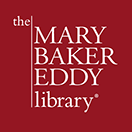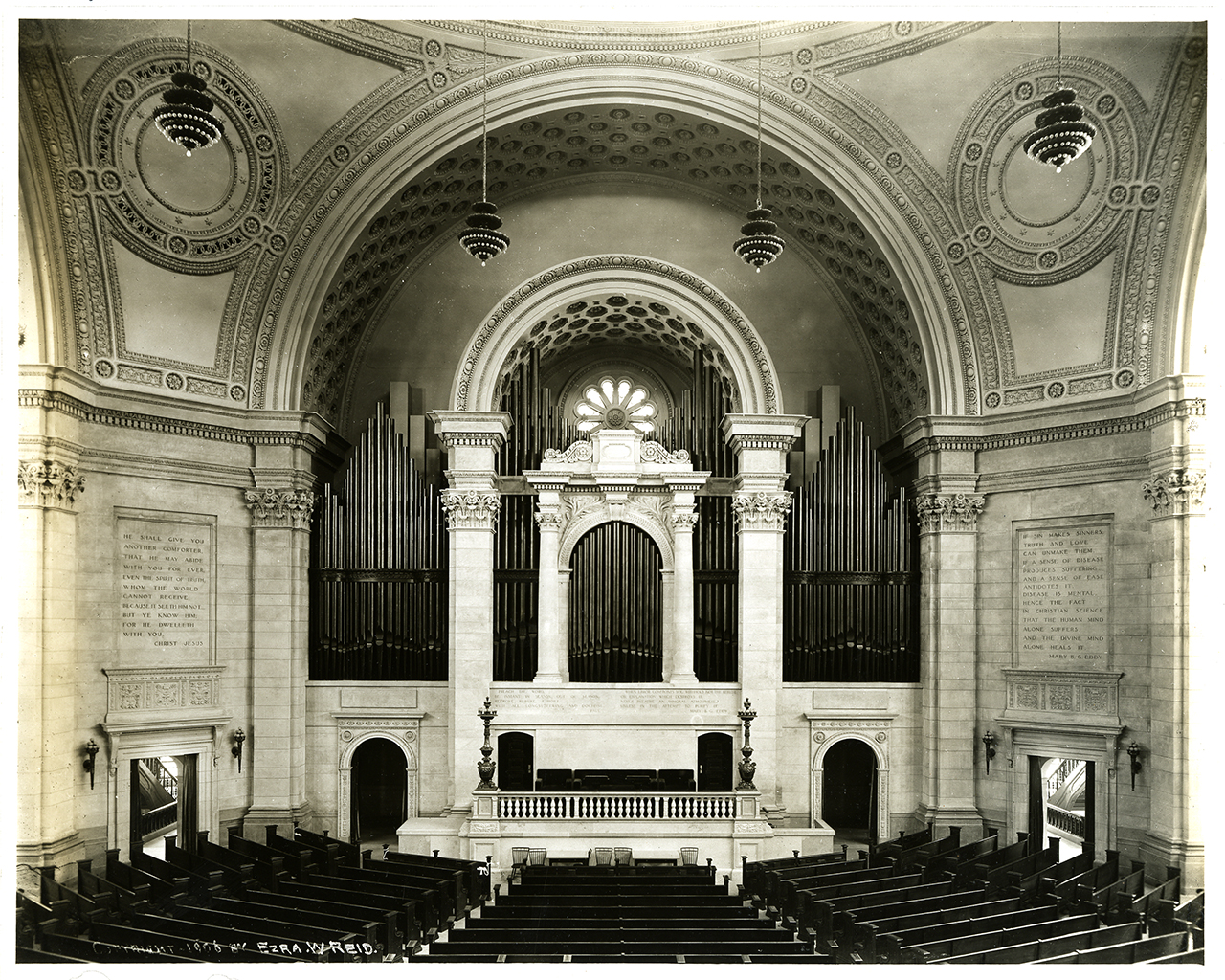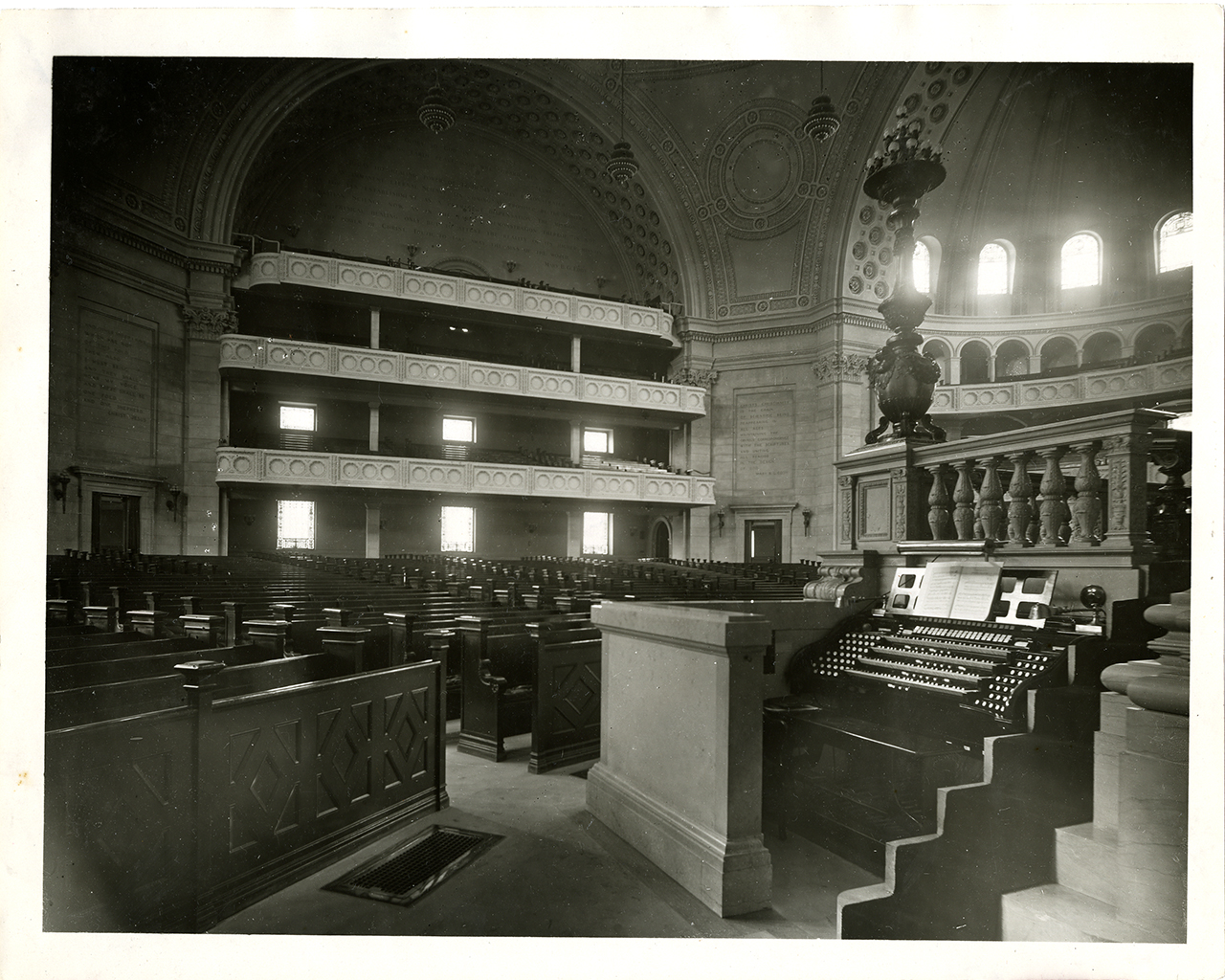The pipe organ in The Mother Church Extension

(Updated September 30, 2022)
Organ music has played a part in Christian Science services and meetings since Mary Baker Eddy founded the church.
Electronic organs and keyboards did not exist when Christian Science gatherings began in the 1870s. The only organs available were pipe organs and the more modest reed organs, also known as pump organs, harmoniums, or melodeons. More portable than pipe organs, reed organs were usually supplied with wind by bellows, continuously pumped by the organist’s feet while playing. These organs were frequently found in parlors and in smaller public halls and were used to accompany the hymn singing in the early church. A student from the fledgling days of Christian Science services, Putney Bancroft recalled his wife playing the melodeon while he attempted to lead the singing at a little hall on Market Street in Lynn, Massachusetts, where Eddy was preaching.1
Eddy was a music lover, and in several passages of her book Science and Health with Key to the Scriptures she compared musical harmony to our mental and physical harmony. In one passage she wrote, “The realization that all inharmony is unreal brings objects and thoughts into human view in their true light, and presents them as beautiful and immortal. Harmony in man is as real and immortal as in music. Discord is unreal and mortal”2
The Original Edifice of The Mother Church in Boston (The First Church of Christ, Scientist) was erected in 1894, with a fine pipe organ built by the prominent Detroit, Michigan, firm of Farrand & Votey. The organ was a gift from Albert Metcalf, whose wife had been healed by Christian Science.
View of the facade of the 1906 Hook & Hastings organ in the Extension of The Mother Church, P08512.
The Extension of The Mother Church, designed to seat 5,000, was completed and dedicated in 1906. A much larger organ was installed there, built by Boston’s Hook & Hastings Organ Company. The Boston Post commented that “there is nothing more wonderful than the organ which has been installed. Nowhere in the world is there a more beautiful, more musical, or more capable instrument.… with four manuals [keyboards], seventy-two stops… and forty-five hundred and thirty-eight pipes, the largest of which is thirty-two feet long.…”3
The four-manual console the Post described was located to the right side of the Readers’ platform. It was replaced in 1928 by a new four-manual console located in front of and below the platform.
From the side, the original console of the 1906 Hook & Hastings organ, circa 1919. P08439.
By the mid-twentieth century, the Hook & Hastings organ needed extensive repairs. The tonal design of the organ was outdated and not really appropriate for the performance of the works of the Baroque era music, which includes the music of Bach—a cornerstone of the organ repertoire. The Hook & Hastings instrument was replaced with a much larger one, built by the Aeolian-Skinner Company, a distinguished Boston organ firm. In 1948 Aeolian-Skinner had installed a large organ in the Mormon Tabernacle in Salt Lake City, Utah. One of the company’s organ architects, Lawrence Phelps, designed The Mother Church’s instrument.
The new organ took over a year and a half to build and install, and was completed in 1952. Its tonal designs gave an organist the ability to perform music of many countries, historical periods, and styles—certainly appropriate for the headquarters of what had become an international church. Designer Phelps gave many technical details about the instrument in an organ magazine titled The Diapason and also included information about the design of the organ’s façade. He related this:
[The project was] the result of many weeks of close collaboration between the organ architect [Phelps] and William G. Perry of the Boston architectural firm of Perry, Shaw, & Hepburn, Kehoe and Dean, the architectural consultant for an extensive program of renovation in which the Mother Church has been engaged. The new design retained and incorporated certain limestone and plaster features that were part of the old front. Most of the old front pipes were also retained and redecorated. About 300 new pipes were added to the display, and there are now 377 polished tin and gold-leafed pipes visible across the front of the organ. The majority of these are speaking pipes.4
As Phelps indicates, the striking display of organ pipes in the auditorium of the church is merely the tip of the iceberg, when one considers the vast number of pipes that lie behind this façade. This is one of the largest organs in the world, with a total of 13,384 pipes, ranging from the size of a pencil to a height of 32 feet.
This organ has been played for church services since 1952. In addition, talented organists over the years have performed in special recitals. The instrument has undergone occasional renovations and updates. In the late 1990s, Phelps oversaw a major restoration, with Foley-Baker, Inc., performing the technical work.
Since the organ’s installation, many thousands have thrilled to its tonal beauty and its ability to range from ethereal whispers to thunderous fortissimos. It’s definitely an instrument that fully supports Eddy’s requirement for music in The Mother Church to be “of a recognized standard of musical excellence.”5
Click here to watch a June 2022 video describing further renovations made to the organ’s console.
Click here to read an article about Ruth Barrett Phelps, The Mother Church’s longest serving organist, including more information on her husband Lawrence Phelps.
- “Letters and Editorial,” The First Church of Christ, Scientist, and Miscellany (Boston: The Christian Science Board of Directors), 60.
- Mary Baker Eddy, Science and Health with Key to the Scriptures (Boston: The Christian Science Board of Directors), 276.
- Eddy, The First Church of Christ, Scientist, and Miscellany (Boston: The Christian Science Board of Directors), 70.
- Lawrence I. Phelps, “Great Organ Placed in C.S. Mother Church,” The Diapason, 1 July 1, 1952, 1, 2, 13.
- Eddy, Manual of The Mother Church, 89th ed. (Boston: The Christian Science Board of Directors, 1908), 61.



